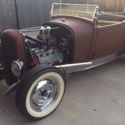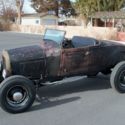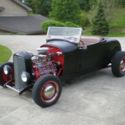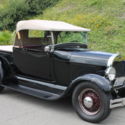1929 Ford Model A Roadster AV8 Flathead Traditional Hotrod
- Price:
- Location: Oak Run, California, United States
- Make: Ford
- Model: Model A
- Type: Roadster
- Trim: Roadster
- Year: 1929
- Mileage: 1,000
- Color: Black
- Engine size: 8BA Flathead
- Number of cylinders: 8
- Transmission: Manual
- Drive type: RWD
- Interior color: Green
- Vehicle Title: Clear
1929 Ford Model A Description
1929 Ford Model A Roadster AV8 Traditional Hotrod
All Henry steel with original body and frame. VIN number still easily readable on frame and matches the California pink slip. Currently registered through June 2017. I will sign over the YOM plates currently on the car with the appropriate DMV form if buyer wants to register the car with those plates in California. Vehicle is located near Redding CA and is available for inspection. Call to make arrangements - 530-510-9706
Won “Best Hot Rod” at the 2015 Sacramento Poor Boys Midnight Mass show.
This was a no compromise build using vintage parts where possible. It needs nothing and is completely sorted out. It starts, runs, drives, shifts and stops perfectly. A 67 page build diary with tons of pictures is available as a PDF. Just contact me and I can e-mail it to you. I am a Mechanical Engineer who loves building cars. But, I’m not wealthy, so I have to sell my last project to fund the next.
Build Details:
Engine Block Code: H 12 G = July 12 1951, 8BA
Rebuild Completed Feb 2013 by Roger Nelson of Salt Lake City. Roger has been building flatheads longer than I’ve been alive.
Block was .040 over, now .060 over, no cracks, no crack repairs, no cylinder sleeves.
Vintage Ford crank ground -.010, -.010. Vintage stock rods, new “pop-up” pistons.
Vintage stock valve train, reground.
New Isky 77B cam.
New Melling oil pump.
New Offenhauser 400 heads professionally polished.
New Bob Drake long shaft wide belt truck style water pumps.
Vintage Ford reground flywheel, new 9” car clutch. The clutch is smooth, light effort and no chatter.
Truck clean-out style oil pan.
Vintage Edmunds 2 carb intake. Edmunds air cleaners.
Offenhauser mechanical fuel pump.
Speedway Stromberg 97 reproduction carbs (reliable!) with adjustable main jets. She is tuned for perfect chocolate brown plugs.
Powergen 12V alternator in a “generator” housing. Powergen starter.
Bubba’s Hot Rod Shop Delco Distributor re-machined and advance curve tuned for a flathead.
Superior Radiator Model A 2 row (oval tubes) aluminum flathead V8 radiator.
Custom mechanical fan assembly using a vintage 30’s style car fan with a modified 8BA mount using roller bearings requiring no maintenance.
Lake Pipes made by Gear Drive and have mufflers (glass packs) built into the cone.
Radiator overflow canister is a WWII airman “bailout” oxygen bottle.
This is a mild (reliable) 239 cu in engine that sounds incredible and has plenty of power for the lightweight roadster. Some would say too much power. Never runs above 180 degrees even when it is 100 degrees outside. Absolutely no leaks of any kind.
Transmission Details:
Case # for the gear set: I8-4434334
Case # for the re-case: I8-6629586Y
The 1936-1939 gear set has the following gears:
Drive Gear: 18
Cluster Gear: 24 / 24 / 18 / 14
2nd: 22 (/24)
L: 29 (/18)
2.82 1st, 1.60 2nd, and 1.00 3rd.
The gear set is in good condition with no chips or cracks. A 1941 truck case was used for the re-build which had pristine thrust surfaces. This is because the truck gear sets use a 2 piece thrust washer setup so that the cluster gear does not ride on the case. The shifter is the 1939 and up double detent type. All bearings and seals were replaced and the shifter was rebuilt. The original synchronizer was re-used because it was in very good condition.
It has a new throw out bearing and new throw out shaft and bushings. She shifts perfectly with a “new transmission” positive feel. The synchros are strong and it never slips out of gear. It bleeds a tiny amount of oil past the gear shafts that pass through the case. It is just how they are.
Rear Axle:
The axle was built-up by Hot Rod Works (Caldwell Idaho) using a 1937 differential and bells and a Rodsville quick change center section. (Photos of the car are on their web site.) The Rodsville center section is a reproduction of the Halibrand with external appearance of the early Culver City units but with the stronger internal rib / pinion support of the later units. Both wheel bearing races on the axle bells were machined down and re-sleeved. The original pinion was machined for the quick change housing and they assembled the axle using the original differential, ring gear and pinion along with new bearings and seals. A #5 change gear set (21/26) with the 4.33 ring/pinion gives a 3.50 final drive. The closed drive torque tube was shortened and fitted with a modified vintage 40-4605-B driveshaft. The driveshaft angle at the gearbox / u-joint is ideal.
Brakes, Pedals, Hubs and Wheels:
Vintage 1940 ford brakes are used for both front and rear, with the rear backing plates having cable operated emergency brake actuators. All 4 brakes have the lower shoe adjusters along with the standard upper adjusters. New wheel cylinders were installed with new shoes and re-production drums.
The rear hubs are original to the axle. The front hubs and spindles are vintage 1942-1948 with new bearings and seals.
The brake pedal, mount and new master cylinder are from a 1941 Ford truck. The brake pedal arm was formed to clear the clutch linkage and line up with the original Model A floor slot. The clutch pedal arm was also modified to fit. The clutch pedal is vintage from a 1930’s car, not sure the exact year. A new pedal pivot pin was modified to adapt the earlier clutch car pedal to the later truck mount. Original linkages were used to connect the clutch throw-out shaft to the pedal. New bushings were installed in the pedals. The parking brake lever is a truck unit converted to carry a cable balancer and operate the rear drums.
The wheels are vintage V8 ford, 16 x 4 in the front and 16 x 4½ in the back. Tires are Firestone (Coker) bias ply.
Chassis / Steering / Front End:
The frame was very straight and clean. The frame was boxed and a fabricated 1932 style mid cross member was modified to fit the 1941 truck pedal assembly. The original middle cross member was removed. The front cross member is original but modified for the radiator mount. The rear cross member is Z’d 2 inches.
A vintage early 1950’s Ford F-1 Pickup truck steering box was rebuilt and heavily modified for better ergonomics. Steering effort is low and precise considering the level of technology. The front axle is vintage Ford with about a 3” drop done the old fashioned way by an old-timer. The king pins are the needle bearing replacement type. The wish bone is vintage 1935/36 with the correct 2” perch boss for the vintage axle. The wish bone was split and mounted to the transmission cross member with about 5 degrees of castor at the king pins.
The front and rear springs were made up from new reversed eye leafs and a combination of additional leafs to make them soft enough to get a smooth ride from the lightweight car.
The rear lower shock mounts are reproduction castings of 1948 ford parts. The front shock upper mounts are vintage 50’s F-1 truck castings with headlight mount sections grafted on from a cut up vintage light bar.
Body:
The body is all Henry steel with some metal patches in the usual places. The doors fit well and the latches work perfectly. The deck lid is rumble style with the exterior handle shaved. The internal latch is operated by reaching through an access opening in the rear cab bulkhead. All the floor panels are steel. The front panel is removable for servicing the master cylinder, clutch linkage etc.
The grill is an authentic 32 Ford Commercial grill that has been filled. The tank was removed from the cowl and the gas cap was filled. A reproduction Hallock style cast aluminum windshield frame was painstakingly fitted to the cowl. The rear view mirror is a vintage piece. The dash and interior panels were fabricated to give the feel of a vintage aircraft. The gauges are a combination of WWII vintage and new aircraft gauges. The ignition / light switch is a NOS vintage WWII aircraft piece that was rebuilt for use in the car. The key is removable. The start pushbutton is a vintage piece used on stationary engines.
Steering wheel is from a 1920s/30s Whippet as far as I know. It has a beautiful cast aluminum hub with Bakelite / hard rubber like rim. No cracks – pristine condition. It was machined to accept a F1 mount to adapt to the custom split column.
Headlights are vintage after-market lights that include the turn signal on the top. I don’t know who made these. I haven’t seen them before which is why I bought them instantly for this build when I ran across them. The turn signals are fully functional front and rear and are controlled by a vintage dash mount Bakelite switch. The tail lights are vintage WWII aircraft IFF lights converted for dual filament bulbs.
The seats are authentic Beech aluminum “bomber” seats with leather cushions. These seats are pristine with no cracks or repairs and great patina. They are very comfortable. I am 6 foot and fit in the car fine. The seat belts are NOS Irving Airchute belts from the 50’s. The original boxes for the belts are included with the car. The shifter and parking brake boots are made from the same leather as the cushions and are mounted with custom fabricated polished aluminum rings.
The fuel tank is a new reproduction Model T tank mounted along with the battery in the trunk.
All exposed wiring and loom is cloth covered.
The paint is hand rubbed lacquer and is very shiny. It has some flaws (a few minor craze spots, rub throughs) and small rock chips, but nothing extreme. It is typical of what was done in the day, which is why it was done the way it was.
The speedometer is a Mach Gauge from a flight simulator. The guts are just a volt meter. The sending unit gears and housing are on the torque tube. But, I have not yet fabricated a sending unit for the gauge to function.
More details and lots of photos are available in the build diary which I can e-mail.
On May-24-16 at 10:06:12 PDT, seller added the following information:****************************************************************************************************************************************
Thanks for all the interest. A few questions have been coming up so I'll clarify a few things.
- The car is not for sale outside of this auction.
- The wheels run true. The tires were mounted by hand to protect the paint. They run without vibration at highway speed so they were not machine balanced. There are no wheel weights.
- The headlights and parking / runninglights come on together. Only the low beams are wired.
- A spare cap, rotor, points and condenser are included in the Napa Echlin boxes for future part number ID.
- I can trailer the car to Sacramento CA at no cost if that helps shipping arrangements.
- I am working on an adapter to be able to use a standard Chevy transmission speed sensor on the torque tube to make the Mach gauge a functional speedometer. No promises at this point. I will provide more information in a couple days.
On May-26-16 at 17:24:35 PDT, seller added the following information:*****************************************************************************
More info on a few items:
- See a video of the car at https://youtu.be/ymUxaZRh-gs
- The speed sending unit adapter is complete and the mach gauge / speedometer is now functional. Its not a fuzzy dice kind of car and there in nothing there just for ornamentation. Same with the mach gauge - I felt bad about not having it functional. The gauge can be seen operating in the video - the car is on jack stands and run in 2nd gear. Readout vrs speed will have to be worked out on the road with GPS.But, I will not drive the car out on the road while the auction is underway. There is a flying lead at the sender that is the raw pulse output. This is for connecting a counter for an odometer should a jurisdiction require it (buyer to install if desired). There is a small "dongle" at the sender that contains a circuit (no electronics, just passive components) that converts the pulse output of the modern speed sensor to a voltage for the Mach Gauge. The listing is maxed out on photos but I can send you a photo of the speedometer sender as installed on the torque tube- just contact me.
- I have both YOM plates although only 1 is on the car. California requires 2 plates for approval for use. If the car is sold in California, both plates will be included along with the DMV transfer. If it is sold outside of California, I'd like to keep one plate to hang on the wallif the buyer is agreeable. If the buyer doesn't want both plates, I would be willing to buy the pair of plates back.
- The choke actuators are linked together on the 2 carbs, but there is no control in the cab. The firewall was pristine, which is very rare,and I could not bring myself to punch a hole for a choke control rod. The choke can be set at the carbs for cold starting.
- I appreciate the offers I've received, but I will not end the auction early. I have given my word that the auction will run its full course, and it will. Those waiting until near the end of the auction to bid can rest assured they will have that opportunity.
I appreciate all the compliments on the car andyour bids.
 1929 Ford Model A Roadster SCTA Hotrod Traditional Hotrod Flathead
1929 Ford Model A Roadster SCTA Hotrod Traditional Hotrod Flathead
Mileage: 1,234
 1929 Ford flathead model A roadster rat rod scta traditional hot street
1929 Ford flathead model A roadster rat rod scta traditional hot street
Mileage: 9,999,999
 1928,1929 Model A Roadster Original Flathead Ford AV 8 Traditional Hot Rod
1928,1929 Model A Roadster Original Flathead Ford AV 8 Traditional Hot Rod
Mileage: 999999
 1929 model A roadster hi boy hot rod Flathead traditional style original steel
1929 model A roadster hi boy hot rod Flathead traditional style original steel
Mileage: 999,999
 1929 Ford Model A Traditional Hotrod
1929 Ford Model A Traditional Hotrod
Mileage: 1,191
 1929 Ford flathead roadster rat rod scta traditional hot street
1929 Ford flathead roadster rat rod scta traditional hot street
Mileage: 9,999,999
 1929 Ford Roadster Pickup Traditional hotrod- high quality, toured in Europe!
1929 Ford Roadster Pickup Traditional hotrod- high quality, toured in Europe!
Mileage: 11,165
 1929 Ford Model A Roadster Pre-war Traditional Hot Rod
1929 Ford Model A Roadster Pre-war Traditional Hot Rod
Mileage: 99000
 1929 Ford Model A Roadster Rat Rod Traditional Hot Rod!
1929 Ford Model A Roadster Rat Rod Traditional Hot Rod!
Mileage: 77,777













 1929 Ford Model A Traditional Custom Hotrod Pickup Truck
1929 Ford Model A Traditional Custom Hotrod Pickup Truck